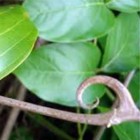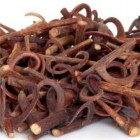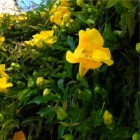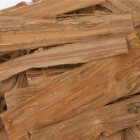Cat's Claw Powdered Extract
- Brand: Brazilian Forest
- Product Code: Plantas Medicinais
- Availability: In Stock
Uncaria tomentosa (Rubiaceae) also known as cat’s claw, is a climber plant, typical of the tropical rain forest from South and Central America, and is traditionally used as a medicinal plant. In the last two decades, around 50 compounds have been isolated from U. tomentosa, from which around 35 can be considered exclusive to this species. These compounds include alkaloids, terpenes, quinolic acid glycosides and phenolic compounds, among them coumarins. The scientific interest for this plant has increased after the confirmation of its immunomodulatory properties mainly attributed to its alkaloid content. Moreover, there is a certain body of scientific evidence that demonstrates a wide spectra of bioactivities for U. tomentosa extracts, including immunomodulatory, antioxidant, antiviral, anti-inflammatory, also suggesting that these effects are due to synergism with other chemical compounds present in the plant. Cat's Claw is used to treat intestinal ailments such as Crohn's disease, gastric ulcers and tumors, parasites, colitis, gastritis, diverticulitis and irritable bowel syndrome. Also the treatment and prevention of arthritis and rheumatism, diabetes, PMS, chronic fatigue syndrome, prostate conditions, immune modulation, Lyme disease, and systemic lupus erythamatosus. Cat's Claw also show effetive in treating cancer, inflammation, viral infection and vascular conditions, and for its use as an immunostimulant, antioxidant, antibacterial and CNS-related agent.
CONSTITUENTS: Phytochemical studies have shown the presence of tetracyclic and pentacyclic oxindole alkaloids as well as quinovic acid glycosides. Polyhydroxylated triterpenes, flavonoids, procyanidines and sterols have also been isolated from the plant. In the first report on its constituents, the leaves and stems of U. tomentosa were found to contain rhynchophylline and isorhynchophylline as the major alkaloids, mitraphylline, isomitraphylline, dihydrocorynantheine, hirsutine and hirsuteine, together with their N-oxides. In addition, rotundifoline and isorotundifoline were found as minor alkaloids in one herbarium sample. The presence of the stereoisomeric alkaloids pteropodine, isopteropodine, speciophylline, Uncarine F and isomitraphylline in the bark of cat's claw was reported. Phenolic constituents, such as flavonoids, phenolic acids, diterpenes and tannins are especially worthy of notice due to their high antioxidative activity. Therefore, over the past few years, a number of medicinal plants have been extensively investigated for the presence and activity of polyphenols and other antioxidants. Cat's claw contains ajmalicine, akuammigine, campesterol, catechin, carboxyl alkyl esters, chlorogenic acid, cinchonain, corynantheine, corynoxeine, daucosterol, epicatechin, harman, hirsuteine, hirsutine, iso-pteropodine, loganic acid, lyaloside, mitraphylline, oleanolic acid, palmitoleic acid, procyanidins, pteropodine quinovic acid glycosides, rhynchophylline, rutin, sitosterols, speciophylline, stigmasterol, strictosidines, uncarine A thru F, and vaccenic acid.
LATIN NAME: Uncaria tomentosa L.
USED PARTS: Bark
DRYING METHOD: Spray Drying
RATIO: 1:1
CARRIER: Maltodextrin (soluble) or Tapioca (starch) (insoluble)
ACTIVE INGREDIENTS: alkaloids, terpenes, quinolic acid glycosides and phenolic compounds, among them coumarins.
PROPERTIES: The main actions performed by Uncaria tomentosa are firstly it stimulates immune system, reduces inflammation, protect cells, fights free radicals, cleanses bowels, cleans cancer cells, kills leukaemia cells and tones balances. Some other actions performed are it relieves pain, kills viruses, detoxifies, lleanses blood, Increases urination, lowers blood pressure, reduces choloestrol, decreases depression. Cat's claw is an effective antioxidant. It is an antioxidant as well as a remarkably potent inhibitor of tumor necrosis factor (TNF) alpha production. TNF represents a model for tumor growth driven by an inflammatory cytokine chemical. The anti-inflammatory actions of cat's claw are not attributable to immunostimulating alkaloids but rather to another group of chemicals called carboxyl alkyl esters. In addition to the immunostimulant alkaloids, cat's claw contains the alkaloids rhynchophylline, hirsutine, and mitraphylline, which have demonstrated hypotensive and vasodilating properties. Rhynchophylline has shown to prevent blood clots in blood vessels, dilate peripheral blood vessels, lower the heart rate, and lower blood levels of cholesterol. Some of the newer research indicates that cat's claw might be helpful to people with Alzheimer's disease. This could be attributable to the antioxidant effects already confirmed or, possibly, to the dilation of peripheral blood vessels in the brain by alkaloids such as rhynchophylline. Cat's claw's immune-stimulating alkaloids pteropodine and isopteropodine might have other properties and applications. These two chemicals have shown to have a positive modulating effect on brain neurotransmitters called 5-HT (2) receptors. These receptor sites are targets for drugs used in treating a variety of conditions, including depression, anxiety, eating disorders, chronic pain conditions, and obesity.
PREPARATION: Standard Dosage: Vine bark
Decoction : 1 cup twice daily.
Capsule : 1-2g two-three times daily.
Tablets : 300.0-500.0 mg two or three times.
Fluid extract : 2-4 ml twice, daily.
Tinctures : 2-4 ml twice, daily.
APPLICATIONS: Nutraceuticals, dietary supplements, food supplements, food supplements, functional foods, medical food, phrmaceuticals.
PRECAUTIONS: Herbalists recommend that cat’s claw not be used during pregnancy, lactation or in children less than three years old, patients undergoing grafts and organ transplants, hemophiliacs, and patients receiving vaccines, sera, immune globulin, insulin or thymus extracts.
For educational purposes only. This information is not intended to diagnose, treat, cure or prevent any disease.











